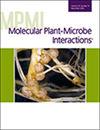求助PDF
{"title":"Dynamic Gene-for-Gene Interactions Undermine Durable Resistance.","authors":"Barbara Valent","doi":"10.1094/MPMI-02-25-0022-HH","DOIUrl":null,"url":null,"abstract":"<p><p>Harold Flor's gene-for-gene model explained boom-bust cycles in which resistance (<i>R</i>) genes are deployed in farmers' fields, only to have pathogens overcome resistance by modifying or losing corresponding active avirulence (<i>AVR</i>) genes. Flor understood that host <i>R</i> genes with corresponding low rates of virulence mutation in the pathogen should maintain resistance for longer periods of time. This review focuses on <i>AVR</i> gene dynamics of the haploid Ascomycete fungus <i>Pyricularia oryzae</i>, which causes rice blast disease, a gene-for-gene system with a complex race structure and a very rapid boom-bust cycle due to high rates of <i>AVR</i> gene mutation. Highly mutable blast <i>AVR</i> genes are often characterized by deletion and by movement to new chromosomal locations, implying a loss/regain mechanism in response to <i>R</i> gene deployment. Beyond rice blast, the recent emergence of two serious new blast diseases on wheat and <i>Lolium</i> ryegrasses highlighted the role of <i>AVR</i> genes that act at the host genus level and serve as infection barriers that separate host genus-specialized <i>P. oryzae</i> subpopulations. Wheat and ryegrass blast diseases apparently evolved through sexual crosses involving fungal individuals from five host-adapted subpopulations, with the host jump enabled by the introduction of virulence alleles of key host-specificity <i>AVR</i> genes. Despite identification of wheat <i>AVR</i>/<i>R</i> gene interactions operating at the host genus specificity level, the paucity of effective <i>R</i> genes identified thus far limits control of wheat blast disease. [Formula: see text] Copyright © 2025 The Author(s). This is an open access article distributed under the CC BY-NC-ND 4.0 International license.</p>","PeriodicalId":19009,"journal":{"name":"Molecular Plant-microbe Interactions","volume":"38 2","pages":"104-117"},"PeriodicalIF":3.4000,"publicationDate":"2025-03-01","publicationTypes":"Journal Article","fieldsOfStudy":null,"isOpenAccess":false,"openAccessPdf":"","citationCount":"0","resultStr":null,"platform":"Semanticscholar","paperid":null,"PeriodicalName":"Molecular Plant-microbe Interactions","FirstCategoryId":"99","ListUrlMain":"https://doi.org/10.1094/MPMI-02-25-0022-HH","RegionNum":3,"RegionCategory":"生物学","ArticlePicture":[],"TitleCN":null,"AbstractTextCN":null,"PMCID":null,"EPubDate":"2025/4/24 0:00:00","PubModel":"Epub","JCR":"Q2","JCRName":"BIOCHEMISTRY & MOLECULAR BIOLOGY","Score":null,"Total":0}
引用次数: 0
引用
批量引用
Abstract
Harold Flor's gene-for-gene model explained boom-bust cycles in which resistance (R ) genes are deployed in farmers' fields, only to have pathogens overcome resistance by modifying or losing corresponding active avirulence (AVR ) genes. Flor understood that host R genes with corresponding low rates of virulence mutation in the pathogen should maintain resistance for longer periods of time. This review focuses on AVR gene dynamics of the haploid Ascomycete fungus Pyricularia oryzae , which causes rice blast disease, a gene-for-gene system with a complex race structure and a very rapid boom-bust cycle due to high rates of AVR gene mutation. Highly mutable blast AVR genes are often characterized by deletion and by movement to new chromosomal locations, implying a loss/regain mechanism in response to R gene deployment. Beyond rice blast, the recent emergence of two serious new blast diseases on wheat and Lolium ryegrasses highlighted the role of AVR genes that act at the host genus level and serve as infection barriers that separate host genus-specialized P. oryzae subpopulations. Wheat and ryegrass blast diseases apparently evolved through sexual crosses involving fungal individuals from five host-adapted subpopulations, with the host jump enabled by the introduction of virulence alleles of key host-specificity AVR genes. Despite identification of wheat AVR /R gene interactions operating at the host genus specificity level, the paucity of effective R genes identified thus far limits control of wheat blast disease. [Formula: see text] Copyright © 2025 The Author(s). This is an open access article distributed under the CC BY-NC-ND 4.0 International license.
动态基因对基因的相互作用破坏了持久的抗性。
Harold Flor的基因换基因模型解释了繁荣-萧条周期,在这种周期中,抗性(R)基因被放置在农民的田地里,只是让病原体通过修改或失去相应的活性无毒(AVR)基因来克服抗性。Flor了解到,在病原体中具有相应低毒力突变率的宿主R基因应该在较长时间内保持耐药性。本文综述了稻瘟病的病原菌——单倍体子囊真菌稻瘟病菌(pyricaria oryzae)的AVR基因动力学,这是一个具有复杂种族结构的基因对基因系统,由于AVR基因的高突变率,其消长周期非常快。高度可变的胚AVR基因通常以缺失和移动到新的染色体位置为特征,这意味着R基因部署的损失/恢复机制。除了水稻稻瘟病外,最近在小麦和黑麦草上出现的两种严重的新稻瘟病突出了AVR基因在宿主属水平上的作用,并作为分离宿主属特异性稻瘟病亚群的感染屏障。小麦和黑麦草瘟病显然是通过涉及五个宿主适应亚群的真菌个体的性杂交进化而来的,宿主跳跃是通过引入关键宿主特异性AVR基因的毒力等位基因实现的。尽管鉴定出小麦AVR/R基因在宿主属特异性水平上相互作用,但迄今为止鉴定出的有效R基因的缺乏限制了小麦稻瘟病的控制。[公式:见正文]版权所有©2025作者。这是一篇在CC BY-NC-ND 4.0国际许可下发布的开放获取文章。
本文章由计算机程序翻译,如有差异,请以英文原文为准。

 求助内容:
求助内容: 应助结果提醒方式:
应助结果提醒方式:


